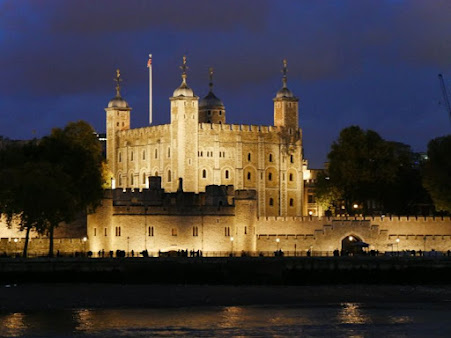Few parts of the UK are as steeped in history as London.
====================================================================(on the north bank of the Thames River in central London, England) The Tower of London is a 1,000 year old castle that protects the Crown Jewels. Throughout its history, it was a secure fortress, a royal palace, and a prison. Today, you can see the displays of the Jewel House, the Tower’s Mint, and the Royal Armories. (The tower also has the world's largest diamond); tours from Yeoman Warders (or "Beefeaters"), offer an array of armor and weaponry, with a sense of ancient history at every turn.
+ A military garrison is maintained within the Tower, which with its precincts constitutes a “liberty” outside local jurisdictions. It is held for the sovereign by a constable, who is now always a field marshal. There is a resident governor, who occupies the 16th-century Queen’s House on Tower Green and is in charge of the“beefeaters,” as they are popularly called. They still live within the Tower, and their responsibilities include guiding tours for its two-to-three million annual visitors. Ravens with clipped wings are kept on the grounds by the yeoman ravenmaster. (A tradition dating from the time of King Charles II states that, should the ravens leave the Tower, the fortification and the state would fall.) By the Tower is Tower Bridge. (The fortress was designated a UNESCO World Heritage site in 1988.)
+ Though the tower has been a royal residence, a treasury, a mint, an armory, and a zoo, it is perhaps most remembered as the prison where a king, three queens, and many nobles met their deaths. Most visitors head straight to the Waterloo Barracks, which contains the spectacular Crown Jewels, including the platinum crown of the late Queen Mother, set with the 106-carat Koh-i-Nûr (Persian for "Mountain of Light") diamond, and the Imperial State Crown, worn by the monarch at the State Opening of Parliament. (Slow-moving walkways slide wide-eyed visitors past the collection.)
+ The Tower of London, officially His Majesty's Royal Palace and Fortress of the Tower of London, lies within the London Borough of Tower Hamlets, which is separated from the eastern edge of the square mile of the City of London by the open space known as Tower Hill. It was founded toward the end of 1066 as part of the Norman Conquest. The White Tower was built by William the Conqueror in 1078 and was a resented symbol of oppression, inflicted upon London by the new Norman ruling class. The castle was also used as a prison from 1100 until 1952.
+ From the early 14th century until the reign of Charles II in the 17th, a procession would be led from the Tower to Westminster Abbey on the coronation of a monarch. In the absence of the monarch, the Constable of the Tower is in charge of the castle. The zenith of the castle's use as a prison was the 16th and 17th centuries, when figures who had fallen into disgrace, such as Elizabeth I (before she became queen), and Sir Walter Raleigh, were held within its walls.





No comments:
Post a Comment